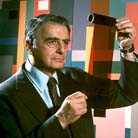 Edwin Herbert Land (May 7, 1909 – March 1, 1991) was an American scientist and inventor, best known as the co-founder of the Polaroid Corporation. Among other things, he invented inexpensive filters for polarizing light, a practical system of in-camera instant photography, and his retinex theory of color vision. His Polaroid instant camera, which went on sale in late 1948, made it possible for a picture to be taken and developed in 60 seconds or less.
Edwin Herbert Land (May 7, 1909 – March 1, 1991) was an American scientist and inventor, best known as the co-founder of the Polaroid Corporation. Among other things, he invented inexpensive filters for polarizing light, a practical system of in-camera instant photography, and his retinex theory of color vision. His Polaroid instant camera, which went on sale in late 1948, made it possible for a picture to be taken and developed in 60 seconds or less.
Although he studied chemistry at Harvard, he left school for New York City after his freshman year. In New York City, he invented the first inexpensive filters capable of polarizing light, Polaroid film. Because he was not associated with an educational institution, he lacked the tools of a proper laboratory, making this a difficult endeavor. Instead, he would sneak into a laboratory at Columbia University late at night to use their equipment. He also availed himself of the New York City public library to scour the scientific literature for prior work on polarizing substances. His breakthrough came when he realized that instead of attempting to grow a large single crystal of a polarizing substance, he could manufacture a film with millions of micrometre-sized polarizing crystals that were coaxed into perfect alignment with each other.
After developing a polarizing film, Edwin Land returned to Harvard. However, he still did not finish his studies or receive a degree. In 1932 he established the Land-Wheelwright Laboratories together with his Harvard physics instructor to commercialize his polarizing technology. After a few early successes developing polarizing filters for sunglasses and photographic filters, Land obtained funding from a series of Wall Street investors for further expansion. The company was renamed the Polaroid Corporation in 1937.
During World War II, he worked on military tasks, which included developing dark-adaptation goggles, target finders, the first passively guided smart bombs, and a special stereoscopic viewing system called the Vectograph which revealed camouflaged enemy positions in aerial photography.
On February 21, 1947, Edwin Land demonstrated an instant camera and associated film. Called the Land Camera, it was in commercial sale less than two years later. In the 1950s, Edwin Land and his team helped design the optics of the revolutionary Lockheed U-2 spy plane.
Although he led the Polaroid Corporation as a chief executive, Land was a scientist first and foremost, and as such made sure that he performed "an experiment each day". Despite the fact that he held no formal degree, employees, friends, and the press respected his scientific accomplishments by calling him Dr. Land.
He retired as Chairman of Polaroid on March 6, 1980. In his retirement years, he founded the Rowland Institute for Science.